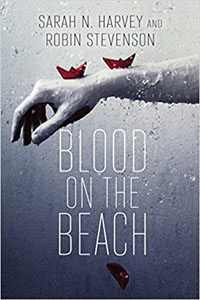| ________________
CM . . .
. Volume XXIII Number 27. . . .March 24, 2017

 |
Blood on the Beach.
Sarah N. Harvey & Robin Stevenson.
Victoria, BC: Orca, 2017.
259 pp., trade pbk., pdf & epub, $14.95 (pbk.).
ISBN 978-1-4598-1293-2 (pbk.), ISBN 978-1-4598-1294-9 (pdf), ISBN 978-1-4598-1295-6 (epub).
Grades 9 and up / Ages 14 and up.
Review by Adam C. Hunt.
*** /4
Reviewed from Advance Reading Copy.
|
| |
|

excerpt:
I [Caleb] didn’t like cops. They never helped my mom after Barry used her for a punching bag. And they came down on me hard when I finally stepped up and turned the tables on the prick. Like I didn’t have any reason to beat the crap out of him after all the times he hit my mom. But the way the cops (and Barry) saw it, I was a danger – not just to Barry, but to society. They kept me locked up for two days because Mom was too busy tending to Barry’s broken nose and his fractured arm to come and bail me out.
When she finally did, she would barely speak to me. And then she made this deal with the cops – it was called diversion – because it was my first offense: I could go to INTRO rather than enter the justice system and maybe end up with a record. Like Alice, I thought the whole INTRO thing was bullshit, including the name. As acronyms go, it was pretty pathetic.
As teacher-librarians, we are always looking for books that will engage reluctant readers, particularly boys. For years, Orca Books has been publishing high interest, low vocabulary fiction that has hooked this difficult audience. Orca is particularly good at publishing short, gritty novels that accurately depict the way that teenagers think, feel, and speak. At my school, students particularly like “Orca Soundings” and “Orca Sports”….they fly off the shelf. Blood on the Beach, a novel by Sarah N. Harvey and Robin Stevenson, is not part of either of those series. Instead, since it is 259 pages, its market is indeed teenagers, but perhaps not reluctant readers. However, I have no doubt that it, too, will be avidly consumed by high school readers, ones eager for its “lost in the wilderness” theme, tight pacing and accurate depiction of so-called “troubled” teens. Indeed, it is the novel’s spin on what seems, at first, to be almost a stereotypical fictional set-up – eight teenagers on a remote island who have to delve into their own “heart of darkness” – that makes the novel much more than just a regular old “whodunit.”
That the novel is meant to be within the classic mystery mode cannot really be questioned when, in the second sentence of the “Acknowledgements” section of Blood on the Beach, the authors thank “Agatha Christie and the other mystery authors whose novels we devoured as kids” (p. 261). And within the novel itself, the characters also make reference to William Golding’s Lord of the Flies, even going as far as discussing which character in the novel is equivalent to Piggy: “It occurred to me [Caleb] that we were in serious Lord of the Flies territory here. Was Tara our Piggy? The timing was off – Piggy dies after they’ve been on the island a while – but no doubt Alice would say that I was Jack, the ultimate savage. And she was Simon, of course, always standing on the moral high ground, making everyone else look bad” (p. 132). Yes, the novel does have some obvious parallels to the Golding novel, but one might question the authors’ choice to make it so pointed. After all, do the literary references in a novel really need to be heavily explained, almost as if the reader would miss it without such pointedly didactic moments?
Still, in general, I do not mean to quibble: the novel represents a success on a number of levels. Its use of double narration is particularly good, narrated as it is by the aforementioned Caleb, a strapping “jock”, and Alice, a diminutive girl, one who hates sports and happens to like girls. Both voices are convincing, which is particularly praiseworthy since the two authors are women. The novel flips between the two voices and also is structured by the days which comprise the week-long “sentence” Caleb, Alice and five other teens (Jason, Chad, Nick, Tara and Mandy) have to serve on a deserted island 15 minutes by boat from the mainland (Vancouver). The teens are supervised by Claire (“young”, “late twenties” and “attractive”), a psychologist, her husband Warren (“shaved head”, and “lots of tats,” ) an ex-cop, and Raheem (“under 30”, “receding hairline”), another counsellor. Soon into the story, Warren dies, a teen goes missing, and the central concern is the following: who is the culprit? Readers will remain mesmerized to the very end, and only what seems to be a very “tacked on” epilogue, Chapter 31, is disappointing.
Blood on the Beach is, however, generally a success, and it will provide a good link to Golding’s Lord of the Flies (a novel that is taught in most Canadian high schools), function as a satisfying mystery, and also depict teens as they are and not simply as we would like them to be.
Recommended.
Adam C. Hunt is teacher-librarian and Head of Social Sciences at Centennial Secondary School in Belleville, ON. He began his career as a teacher of young offenders.

To comment
on this title or this review, send mail to cm@umanitoba.ca.
Copyright © the Manitoba Library Association. Reproduction for personal
use is permitted only if this copyright notice is maintained. Any
other reproduction is prohibited without permission.
Next Review | Table of Contents For This Issue - March 24, 2017
CM Home | Back Issues
| Search
| CM Archive
| Profiles Archive
|
